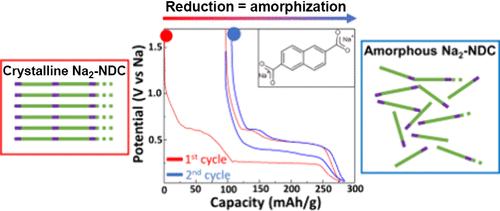2,6-萘二羧酸钠结构-反应性关系的操作x射线衍射和透射电镜研究
IF 7
2区 材料科学
Q2 CHEMISTRY, PHYSICAL
引用次数: 0
摘要
萘二甲酸二钠(Na2-NDC)最近在全电池装置中表现出了良好的负极性能。然而,其电化学反应性和降解机理尚不完全清楚。本文采用operando x射线衍射和死后透射电镜相结合的方法研究了循环过程中Na2-NDC的结构和微观结构演变。在第一次还原过程中观察到非晶化,结构降解和物质损失,表明重要的结构不稳定或重组。为了超越结晶度与电化学反应性之间的联系,采用球磨法对Na2-NDC的晶体组织进行了扰动。结晶度的丧失导致了电化学响应的变化,突出了这些参数对钠离子插入的重要性,特别是对于长期循环。本文章由计算机程序翻译,如有差异,请以英文原文为准。

Investigation of 2,6-Sodium Naphthalene Dicarboxylate Structure–Reactivity Relationship by Operando X-ray Diffraction and Post-Mortem Transmission Electron microscopy
Disodium naphthalene dicarboxylate (Na2-NDC) recently demonstrated promising performance as a negative electrode in full-cell setups. However, its electrochemical reactivity and degradation mechanisms are still not fully understood. In this article, operando X-ray diffraction and post-mortem transmission electron microscopy were combined to investigate the structural and microstructural evolution of Na2-NDC during cycling. Amorphization, structural degradation, and loss of matter were observed during the first reduction, suggesting important structural instability or reorganization. To go beyond the link between crystallinity and electrochemical reactivity, the crystallographic organization of Na2-NDC was disturbed using ball-milling. The loss of crystallinity led to a change in the electrochemical response, highlighting the importance of such parameters to accommodate sodium-ion insertion, especially for long-term cycling.
求助全文
通过发布文献求助,成功后即可免费获取论文全文。
去求助
来源期刊

Chemistry of Materials
工程技术-材料科学:综合
CiteScore
14.10
自引率
5.80%
发文量
929
审稿时长
1.5 months
期刊介绍:
The journal Chemistry of Materials focuses on publishing original research at the intersection of materials science and chemistry. The studies published in the journal involve chemistry as a prominent component and explore topics such as the design, synthesis, characterization, processing, understanding, and application of functional or potentially functional materials. The journal covers various areas of interest, including inorganic and organic solid-state chemistry, nanomaterials, biomaterials, thin films and polymers, and composite/hybrid materials. The journal particularly seeks papers that highlight the creation or development of innovative materials with novel optical, electrical, magnetic, catalytic, or mechanical properties. It is essential that manuscripts on these topics have a primary focus on the chemistry of materials and represent a significant advancement compared to prior research. Before external reviews are sought, submitted manuscripts undergo a review process by a minimum of two editors to ensure their appropriateness for the journal and the presence of sufficient evidence of a significant advance that will be of broad interest to the materials chemistry community.
 求助内容:
求助内容: 应助结果提醒方式:
应助结果提醒方式:


